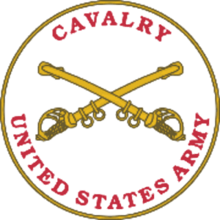
Back سلاح الفرسان الأمريكي Arabic US-Kavallerie German سوارهنظام ایالات متحده آمریکا Persian Cavalerie des États-Unis French 미국 기병대 Korean Cavalaria dos Estados Unidos Portuguese Кавалерія США Ukrainian
This article includes a list of general references, but it lacks sufficient corresponding inline citations. (September 2009) |
| United States Cavalry | |
|---|---|
 Cavalry branch plaque | |
| Active | 1775–1950 |
| Country | |
| Branch | |
| Type | Cavalry |
| Role | Reconnaissance, security (e.g., flank screening, advance guard, rear guard, combat out post, etc.), and economy of force missions |
| Patron | Saint George |
| Insignia | |
| Branch insignia |  |

The United States Cavalry, or U.S. Cavalry, was the designation of the mounted force of the United States Army. The United States Cavalry was formally created by an act of Congress on 3 August 1861 and ceased as a distinct Army branch in 1942.[1] The name "cavalry" continues to be used as a designation for various specific United States Army formations and functions.
This branch, alongside the Infantry and Artillery branches, was formerly considered to be one of the "classic" combat arms branches (defined as those branches of the army with the primary mission of engaging in armed combat with an enemy force).
From the United States Declaration of Independence and the American War of Independence onwards, mounted troops were raised ad-hoc by the United States as emergencies presented themselves and were disbanded as soon as these had passed.[2][3] In 1833, Congress created the 1st U.S. Dragoons, followed by the 2nd U.S. Dragoons and the U.S. Mounted Riflemen 1836 and 1846 respectively.[2][4] The 1861 Act converted the U.S. Army's two regiments of dragoons, one regiment of mounted riflemen, and two regiments of cavalry into one branch of service.[1]
Immediately preceding World War II (1941–1945), the U.S. Cavalry began transitioning to a mechanized, mounted force. During the Second World War, the Army's cavalry units operated as horse-mounted, mechanized, or dismounted forces (infantry). The last horse-mounted cavalry charge by a U.S. Cavalry unit took place on the Bataan Peninsula, in the Philippines in early 1942. The 26th Cavalry Regiment of the allied Philippine Scouts executed the charge against Imperial Japanese Army forces near the village of Morong on 16 January 1942.[5]
In March 1942, the War Department eliminated the office of Chief of Cavalry and effectively abolished the horse cavalry.[6] The cavalry name was absorbed into the Armor branch as part of the Army Reorganization Act of 1950 and the Vietnam War saw the introduction of helicopters and operations as a helicopter-borne force with the designation of Air Cavalry, while mechanized cavalry received the designation of Armored Cavalry.
The term "cavalry", still remains in use in the U.S. Army for mounted (ground and aviation) reconnaissance, surveillance, and target acquisition (RSTA) units based on their parent Combat Arms Regimental System (CARS) regiment. The 1st Cavalry Division is the only active division in the United States Army with a cavalry designation and maintains a detachment of horse-mounted cavalry for ceremonial purposes.
- ^ a b Price (1883) p. 103, 104
- ^ a b Price (1883) p. 12
- ^ Smith (2001) p. 1, "...There existed among the people of the United States a strong prejudice against maintaining even a small regular army in time of peace."
- ^ Grant (2009) p. 23, "I was anxious to enter the cavalry, or dragoons as they were then called..."
- ^ Johnson p. 176, 177.
- ^ Johnson p. 177